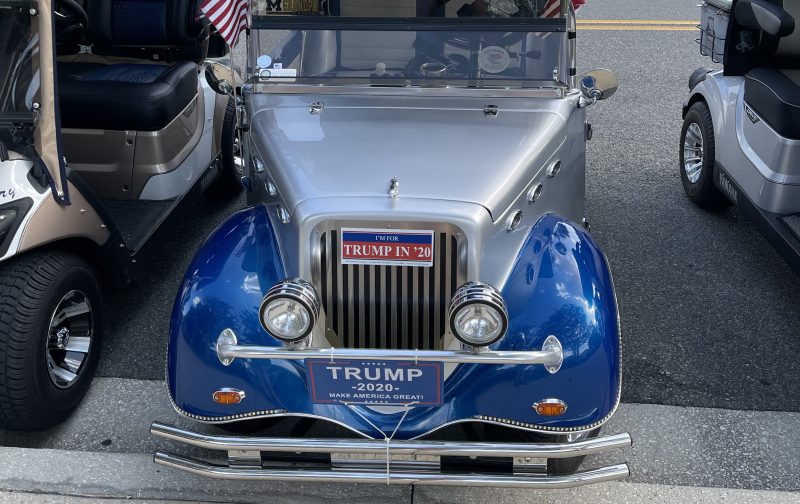With news that another resident of the Villages has admitted to voting multiple times in 2020, we are republishing this story about the ways in which that Florida community uniquely overlaps with Donald Trump’s politics.
The Villages is an odd place. That’s by design; the increasingly expansive retirement community just northwest of Orlando was created to serve as a simulacrum of an America that never really existed.
Residents live in “villages,” housing developments that are connected by both roads and — accommodating a more frequent form of transportation — golf-cart paths. There are three town centers (with a fourth under development), spaces meant to replicate small towns complete with fictional backstories. So you’ll have a building that features weathered (and fake) text indicating that it used to be, say, a newspaper’s office, that is actually home to one of those midrange jewelry shops that are popular in touristy areas. You’ll have some big house that was purportedly the residence of some fictional founder of the fictional town that is now a Medicare assistance center.
Its residents celebrate the informal slogan for the community, that it’s Disney World for adults. But it is, in an unflattering way: It’s a vision of what some people think America should or could look like with great pains taken to protect that illusion.
So it’s fitting that the Villages should now be the epicenter of a small outbreak of America’s second-most-commonly detected affliction: voter fraud.
On Jan. 3, a resident of the Villages, Charles Barnes, was arrested for allegedly having voted more than once in the 2020 election. It was the fourth such arrest in the past month; in December, three others were arrested for having allegedly committed the same crime. In each case, the person is accused of having cast ballots from Florida but also other states where they had residences, including Michigan, New York and Connecticut. Three of the four were registered Republicans at the time of the election.
This, of course, is what voter fraud usually looks like: isolated examples of individuals casting more than one ballot. For all of former president Donald Trump’s sweeping allegations of rampant fraud mechanisms at play in myriad states to benefit Democrats, there’s not only no evidence that such conspiracies were undertaken but what we do know about the scattershot incidents in which illegal votes may have been cast suggests that it’s a bipartisan problem. In the modern political era, there are only rare examples of systematic efforts to swing elections with incidents of fraud far more often being a function of what appears to have happened in Florida.
But that it happened so often at the Villages is fascinating. This may simply be a function of population density. The Villages was the fastest-growing metropolitan area in the United States over the past decade, a surge in population so large that it helped pull Florida’s population center back to the northwest away from Miami. It has a lot of residents and a lot of new residents; when I was there in May, a display in one of the business offices for the Villages’ umbrella corporation (the Villages Operating Company) showed several dozen new arrivals that week alone. Get a lot of people in one place with dual residences and the odds of such behavior increase.
It’s also the case that the Villages is robustly political in a way that other communities are not. It’s a center of political attention, thanks to its high density of older voters. Trump visited more than once, including just over a week before the 2020 election. Reps. Matt Gaetz (R-Fla.) and Marjorie Taylor Greene (R-Ga.) included the area on their “America First” tour last year. Villagers often decorate their golf carts to reflect their personalities; many in early 2021 were still festooned with Trump-supportive regalia.
If you think about it, the Villages reflects a very Trumpian aesthetic. “Make America great again,” after all, is a slogan meant to evoke a sense of what the country used to be even if it never actually was that. The creators of the Villages literally made that idealized America, over and over again. The Villages is to a community what Trumpism is to politics: an appeal to what was and an excoriation of what is.
It’s also interesting that the Villages achieves this idyllic community through very careful, top-down management. The Villages’s shared spaces are a careful construct maintained by the umbrella corporation. Its Villages-specific newspaper is owned by the Villages Operating Company, as is the local radio station that’s piped throughout the town centers. (News for that station is provided by a syndicated Fox feed.) Re-creating Cold War-era Americana ironically requires heavy central planning.
The result? A heavily Republican (Sumter County went for Trump by a 2-to-1 margin in 2020) community coddled by Republican politicians in which primacy is placed on an idealized America of the sort that Trump promised to restore. A community where numerous residents were no doubt sympathetic to Trump’s campaign pitch and to his claims that the Democrats were cheating — and who had residences and voter registrations in multiple states.
Voter fraud is rare, and there’s no indication that anything systematic was at play at the Villages. Except, of course, for a systematic sense of isolation against a changing America and a systematic attempt to convince voters aggrieved in that way to ensure that Trump earned another four years in office.

